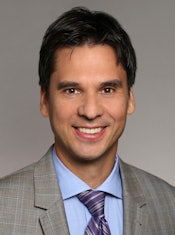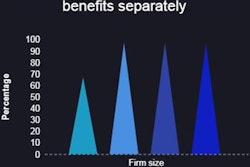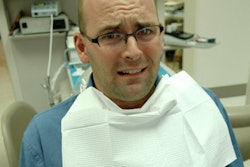
The number of working-age adults who have dental benefits rose in 2014 compared to the year before, partly because of the Patient Protection and Affordable Care Act (ACA), according to two new ADA Health Policy Institute briefs released on October 15.
 Marko Vujicic, PhD, chief economist and vice president of the ADA Health Policy Institute. Image courtesy of the ADA.
Marko Vujicic, PhD, chief economist and vice president of the ADA Health Policy Institute. Image courtesy of the ADA.However, the gap between low- and high-income adults who have received dental care has increased, the researchers Kamyar Nasseh, PhD, and Marko Vujicic, PhD, found. Only 20.3% of poor working-age adults received dental care in 2014, less than half of the 49.2% of higher-income adults who saw a dentist that year.
The number of working-age adults with private dental benefits rose from 56.2% in 2013 to 58.1% in 2014. And the uninsured rate among working-age adults fell from 33.3% in 2013 to 29.4% in 2014.
Effects of ACA, Medicaid expansion
Studies show that expanding Medicaid dental coverage to adults (ages 19-64) increases the number of people who visit the dentist, and dental practices have the capacity to treat more patients, according to the brief titled "Dental Benefits Coverage Increased for Working-Age Adults in 2014."
Increased dental care utilization among children has been primarily driven by the expansion of dental benefits in Medicaid and the Children's Health Insurance Program (CHIP), the researchers reported. In addition to mandating coverage for children younger than age 18, the ACA allows children to stay on a parent's health insurance up to age 26.
2014 was the first year in which many provisions of the ACA took effect, and most adults who were enrolled in Medicaid in 2014 lived in states that provided adult Medicaid dental benefits. The researchers estimated that 6.7% of working-age adults were enrolled in Medicaid programs that provided adult dental benefits in 2014.
Also, only 11% of children had no dental benefits in 2014, the lowest level since 1999.
Impact of insurance marketplaces
For 2016 coverage, 15.1% of adults bought dental insurance in federally facilitated marketplaces, and 13.2% of children were covered by dental benefits purchased in these marketplaces, according to the researchers. These figures mean that about 1.3 million adults and 114,037 children were covered by standalone dental plans that were purchased in the marketplaces.
"These 2014 trends could be a result of the Affordable Care Act, namely the Medicaid expansion provision, as well as the establishment of health insurance marketplaces where adults can purchase dental benefits," wrote ADA researchers Kamyar Nasseh, PhD, and Marko Vujicic, PhD.
| Percentage of U.S. adults with dental coverage | |||
| 2013 | 2014 | ||
| Adults with private dental benefits | 56.2% | 58.1% | |
| Adults without dental benefits | 33.3% | 29.4% | |
| Adults on Medicaid | 10.5% | 12.5% | |
Receiving dental care
Between 2002 and 2014, the number of adults who went to the dentist declined overall. However, "dental care utilization among working-age adults has remained flat since 2012 after nearly a decade of decline," the researchers wrote in their second brief, titled "Dental Care Utilization Steady Among Working-Age Adults and Children, Up Slightly Among the Elderly."
“These 2014 trends could be a result of the Affordable Care Act.”
Among those with private dental insurance, fewer working-age adults received dental care between 2013 and 2014, with dental care utilization decreasing from 49.3% to 48.6%, they noted. Among uninsured working-age adults, only 15.1% saw a dentist in 2014, down from 17.1% in 2013.
In 2014, 6.7% of working-age adults were on Medicaid programs that provided dental benefits, and the number of low-income adults who went to the dentist increased by 2.5%, according to the report.
"Financial barriers to dental care are also falling among poor adults," the researchers wrote.
More elderly people went to the dentist in 2014, continuing an upward trend that began in 2000, they noted.
The number of children with private dental insurance who saw a dentist in 2014 (58.5%) remained the same as 2013. But the number of children who had public dental benefits such as Medicaid and CHIP saw a dentist less often, with the annual visitation rate declining from 42.4% in 2013 to 41% in 2014.
And children without dental benefits were seeing dentists less often in 2014 as well, with the annual visitation rate falling from 24.9% in 2013 to 22.6% in 2014, continuing a downward trend which began in 2000.
More coverage doesn't mean access to care
However, because of the expansion of Medicaid under the ACA by 32 states (according to familiesusa.com), more working-age adults with public health insurance received dental care, increasing from 20% in 2013 to 22.5% in 2014, the researchers noted.
Although an estimated 5.4 million adults gained dental benefits through Medicaid through 2015, the researchers stated that it doesn't mean they were able to see a dentist.
"Increased Medicaid dental benefits coverage does not necessarily equate to increased access to dental care," they pointed out.
Higher Medicaid reimbursements and less paperwork will attract dental providers to participate in Medicaid programs, they said.



















